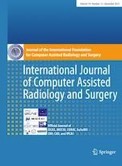Ultrasound in augmented reality: a mixed-methods evaluation of head-mounted displays in image-guided interventions

Augmented reality (AR) and head-mounted displays (HMD) are current subjects of investigation in medical practice. A commonly proposed use-case of AR-HMDs is to display data in image-guided interventions. Although technical feasibility has been thoroughly shown, effects of AR-HMDs on interventions are not yet well researched, hampering clinical applicability. Therefore, the goal of this study is to better understand the benefits and limitations of this technology in ultrasound-guided interventions.
We used an AR-HMD system (based on Hololens, Microsoft Corp.) which overlays live ultrasound images spatially correctly at the location of the ultrasound transducer. We chose ultrasound-guided needle placements as a representative task for image-guided interventions. To examine the effects of the AR-HMD, we used mixed methods and conducted two studies in a lab setting: (1) in an experimental study, we asked participants to place needles into a training model and evaluated task duration and accuracy with the AR- HMD as compared to the standard procedure without visual overlay and (2) in a qualitative study, we analysed the user experience with AR-HMD using think-aloud protocols during ultrasound examinations and semi-structured interviews after the task.
Participants (n=20) placed needles more accurately (mean error of 7.4 mm vs. 4.9 mm, p=0.022) but not significantly faster (mean task duration of 74.4 s vs. 66.4 s, p=0.211) with the AR-HMD. All participants in the qualitative study (n=6) reported limitations of and unfamiliarity with the AR-HMD, yet all but one also clearly noted benefits and/or that they would like to test the technology in practice.
We present additional, though still preliminary, evidence that AR-HMDs provide benefits in image-guided procedures. Our data also contribute insights into potential causes underlying the benefits, such as improved spatial perception. Still, more comprehensive studies are needed to ascertain benefits for clinical applications and to clarify underlying mechanisms.
Authors are Christoph Rüger, Markus A. Feufel, Simon Moosburner, Christopher Özbek, Johann Pratschke, and Igor M. Sauer.

